
As we deal with Artificial Intelligence (AI) in so many aspects of our lives (think Siri, Alexa, even your car navigator), and as the single candle burns brightly atop the cake celebrating our first year with ChatGPT November 30, sometimes it feels that this birthday party comes with a huge piñata. When the blindfolded party-goers gather around it – and some are truly blindfolded! — and hit it with a stick, it spews all kinds of interesting, and often useful, treats. Like colorful confetti, this AI piñata gives us innovations, breakthroughs, efficiencies, tons of data and information, along with many fears and uncertainty, and, of course, ethical questions.
As a society, we seem to be dealing with all of these issues simultaneously, often surprised, mesmerized, marveled, sometimes confused, and more than once tip toeing around them, the way young parents do when entering their newborn’s room . Perhaps we need to think of this mix of emotions in terms of how the famous Spanish philosopher José Ortega y Gasset put it: ‘To be surprised and marvel is to begin to understand”.

José Ortega y Gasset, Spanish philosopher, 1883-1955
–image by Midjourney
That’s a helpful thought from Ortega y Gasset, whose famous work, The Revolt of the Masses (La Rebelión de las Masas), critiques the rise of the “mass man,” a figure who is uninterested in higher values or individual excellence and poses a threat to cultural and intellectual standards.
Is it possible that, in the world of Artificial Intelligence, Ortega y Gasset’s despicable “mass man” is the robot? Critics of AI would agree that robots are uninterested in higher values or individual excellence and, definitely, pose a threat to cultural and intellectual standards. Could The Rebellion of the Robots be an essay already brewing in a contemporary philosopher’s head?
I wonder how Ortega y Gasset would approach Artificial Intelligence, considering that he introduced the concept of perspectivism, which states that reality is accessed through multiple perspectives, with each person’s life and experiences shaping their view of the world.
Following Ortega y Gasset’s perspectivism, AI could be seen as another perspective of reality, although he would probably point out that, unlike the humans whose life and experiences shape their view of the world, AI’s robots possess neither—-just tons of data that the humans’ life and experiences, and creativity, have provided.
Which brings us to a term we don’t see used often: Artificial Creative Intelligence.
Is there such a thing?
I know I get into a very deep and dark cave here, but I have a flashlight in hand and I am ready for this intellectual adventure.
I recently posted a blog comparing an illustration created by a human illustrator for the Wall Street Journal, and then the various illustrations “created” for the same subject by AI’s Midjourney, below.
As one retired art director I know put it: “I wish I liked this.”
I felt like saying, this is not about liking or not liking, but about understanding, adapting and putting guardrails in place for AI use.
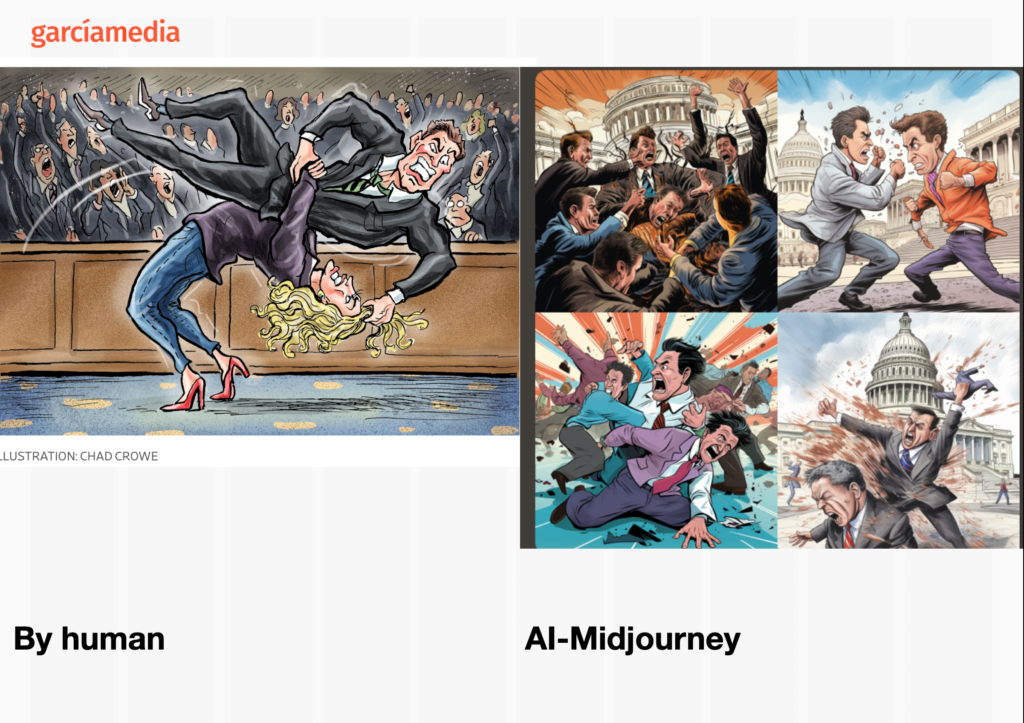
Artificial Creative Intelligence
Artificial creativity, particularly as it manifests in Artificial Intelligence (AI), presents a rich field of philosophical inquiry, especially relevant to journalists and designers who are increasingly interacting with AI in their professional fields.
Some would argue that traditional definitions of creativity often center on human characteristics like originality, expressiveness, and the ability to generate ideas that are both novel and useful.
Some common elements that define creativity include:
Originality: The ability to generate ideas, solutions, or expressions that are new, novel, or unique.
Flexibility: Being able to think divergently, considering multiple perspectives or approaches to a problem or concept.
Fluency: Generating a high quantity of ideas or solutions, showing an abundance of creative output.
Elaboration: Developing and refining ideas, expanding on initial concepts to create something more substantial.
Also, Problem-Solving, Relevance of Ideas, Imagination and Adaptability–being open to change. Most important, Expertise, the ability to draw on a foundation of knowledge or skill to generate creative ideas.
These factors can vary in significance depending on the context, field, or situation in which creativity is being assessed or applied. Additionally, creativity is subjective, and what is considered creative can differ widely among individuals and cultures.
Yet, can those definitions apply to robots?
In the context of AI, these definitions must be expanded or reinterpreted. AI creativity is not about replicating human thought processes, but about creating outputs that can be deemed creative if they were produced by human standards. This raises the question of whether creativity is an inherent quality or a perceived attribute based on the output’s characteristics.
Another fundamental debate is whether AI should be considered merely a tool used by human creators or as a creator in its own right. This debate touches on issues of authorship, ownership, and the nature of the creative process. For journalists and designers, this distinction is crucial in considering how they credit AI-generated content and understand their own roles in the creative process.
Immediately, if the question was posed by a student in my class, or a participant in my professional workshops, my reaction would be:
Humans create, robots regurgitate.
Will that change in the future? Perhaps. Today, however, artificial creative intelligence is an echo based on foundations (learning) fed into the robots’ neural network from the humans who created it. The robot comes to the table where humans have an ample spread to feed it.
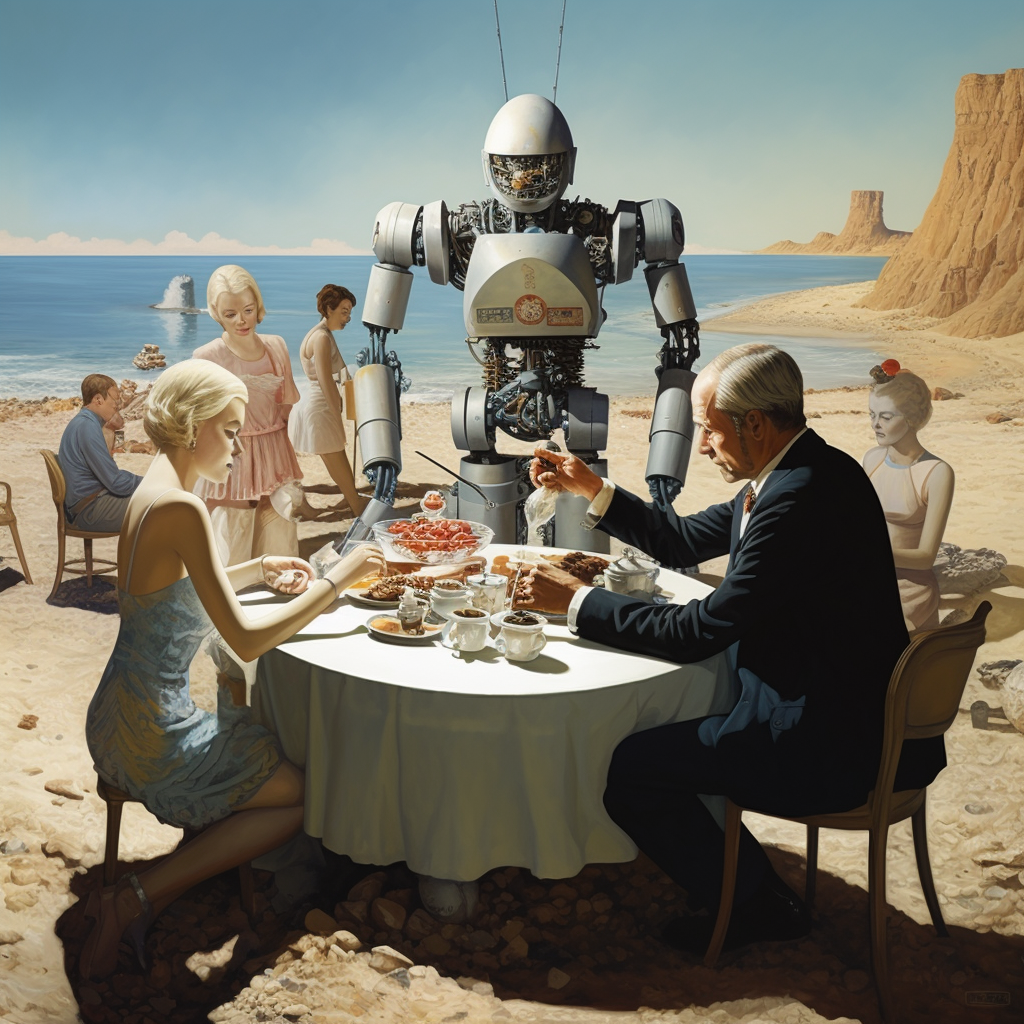
Nonetheless, we are mesmerized by what we see coming out of AI, and the speed with which it can provide us with acceptable visuals, as these two, prompted with just the words: Human feeds content to the robot.
By the way, to provide diversity in the characters that Midjourney will populate its illustrations with, it is important to prompt with specific references. For example, for the image below (right) , I asked for the illustration to be in the style of Serge Attukwei Clotte, a Ghanaian artist who uses yellow as a predominant color in his art. The illustration on the left uses the style of Bo Bartlett, an American artist whose work is characterized by realism and muted colors.
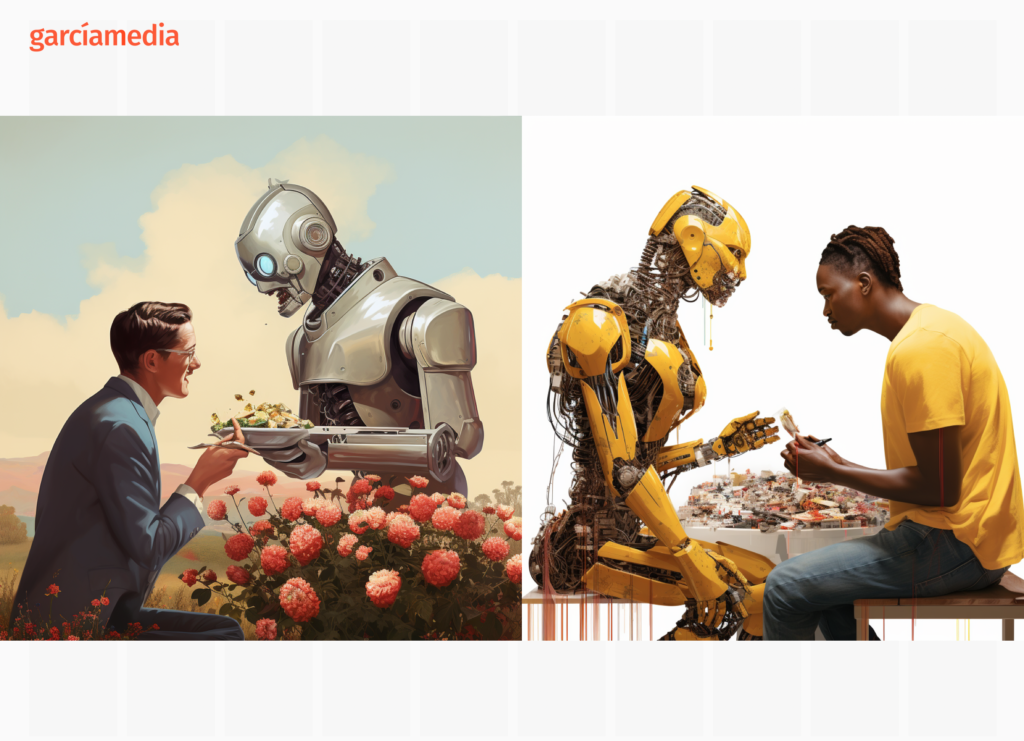
The robot and creativity
Take for example the art created for this blog post. I am not an illustrator and continue to be in awe of the artists with whom I have the pleasure of working around the planet.
But I can go to Midjourney or Dall-E and feed the robots the text of my blog and get these renditions:
Prompt #1
Poster illustration for my blog: As we deal with Artificial Intelligence (AI) in so many aspects of our lives (think Siri, Alexa, your car navigator), and as the one candle-cake celebrating the first year of ChatGPT burns brightly, sometimes we feel that this birthday party also has a huge piñata that when the blindfolded people around it—and some are truly blindfolded!— hit it with a stick it spews out all kinds of interesting, and some useful, things. Like colorful confetti, this AI piñata gives us innovations, breakthroughs, tons of data and information, fears and uncertainty, and, of course, ethical questions. Futuristic. Cinematic. Colorful.
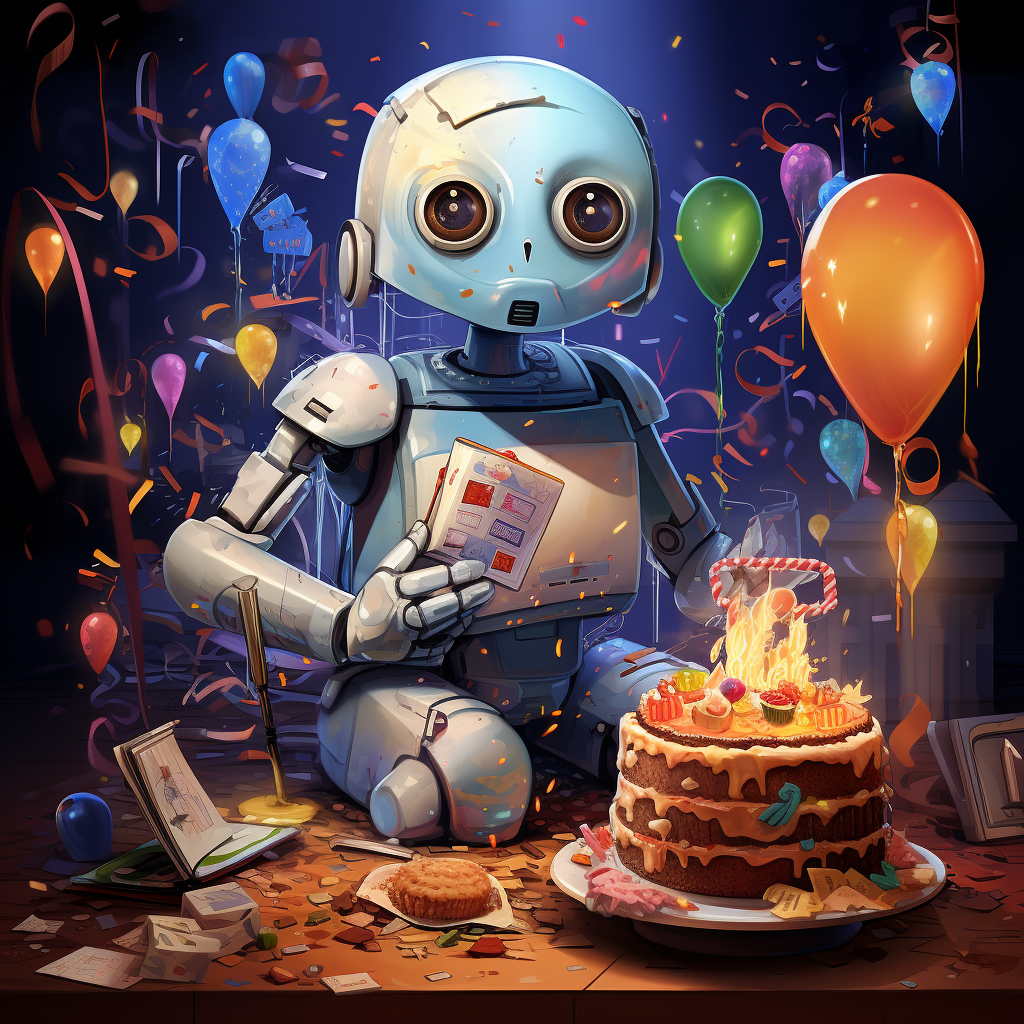
Prompt #2
Poster illustration of a Artificial Intelligence piñata a huge piñata spews out all kinds of interesting, and some useful, things. Like colorful confetti, this AI piñata gives us innovations, breakthroughs, tons of data and information, fears and uncertainty, and, of course, ethical questions. Futuristic. Cinematic. Colorful–texts, illustrations, data
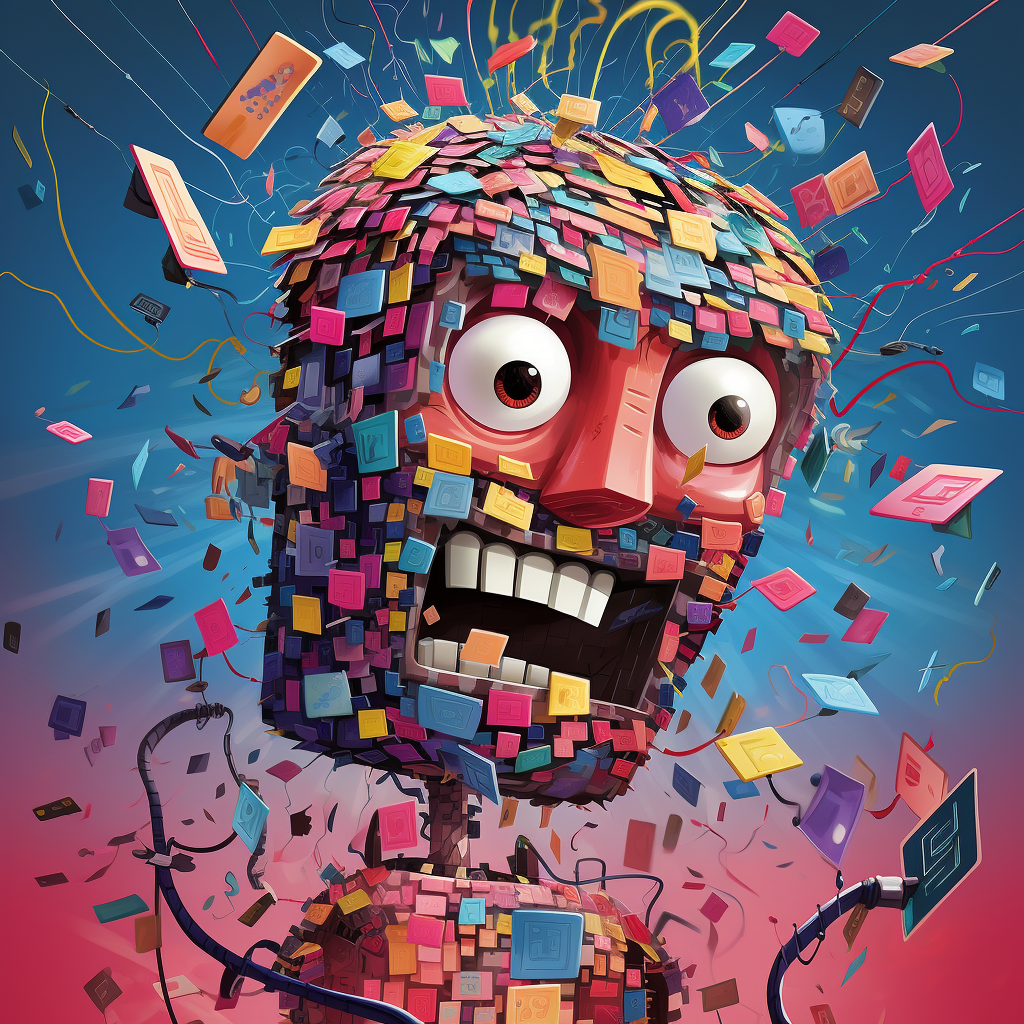
Prompt #3
Poster illustration of a robot piñata spewing out texts, numbers, illustrations, video, audio, news, information, colorful, cartoonish

So, as we continue to experiment with AI, let’s pay attention to the role that Artificial Creative Intelligence may also play.
Perhaps the Ortega y Gasset’s thought that “to be surprised and marvel is to begin to understand” applies here.
AI does indeed spark surprise and marvel. Maybe we are on our way to understanding what this is all about. A long road, I know.
But it starts with transparent conversations as we try to understand AI.
What do you think?
Is there a difference between AI and “artificial creative intelligence”? And if so, how should we approach these differently? We can start the dialog here. Email me your comments: mario@garciamedia.com
Blog post # 3382